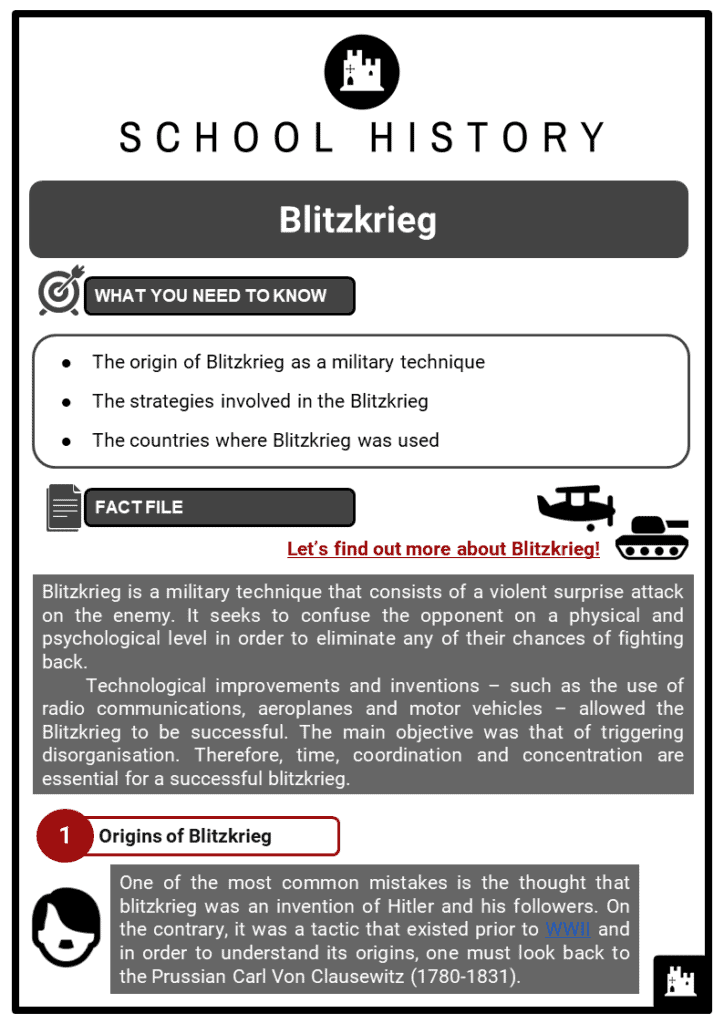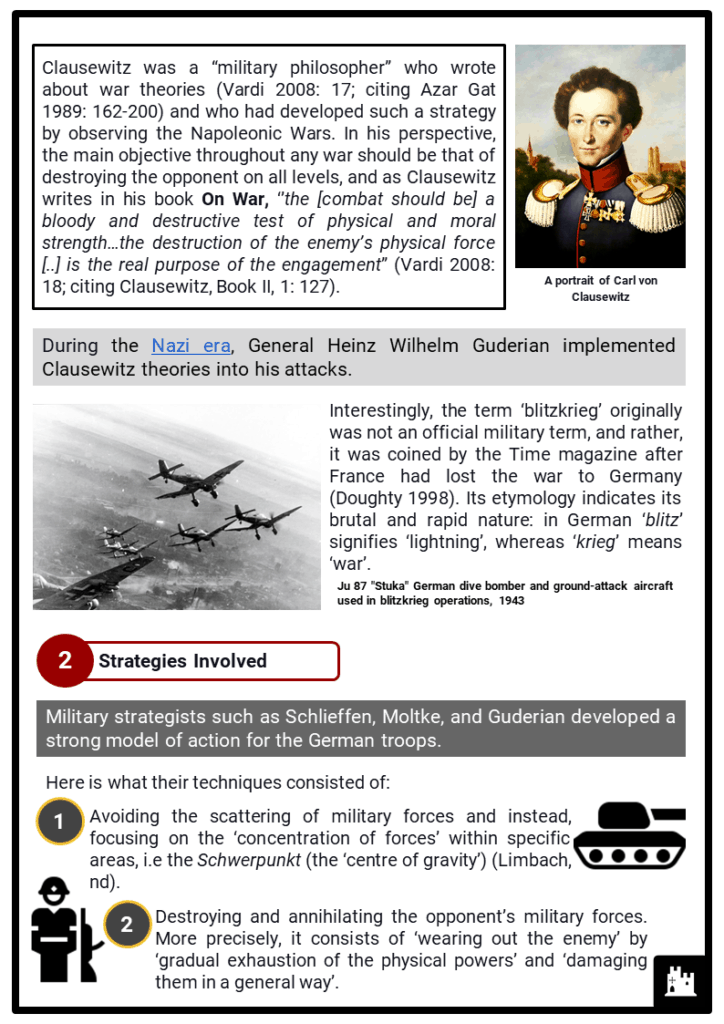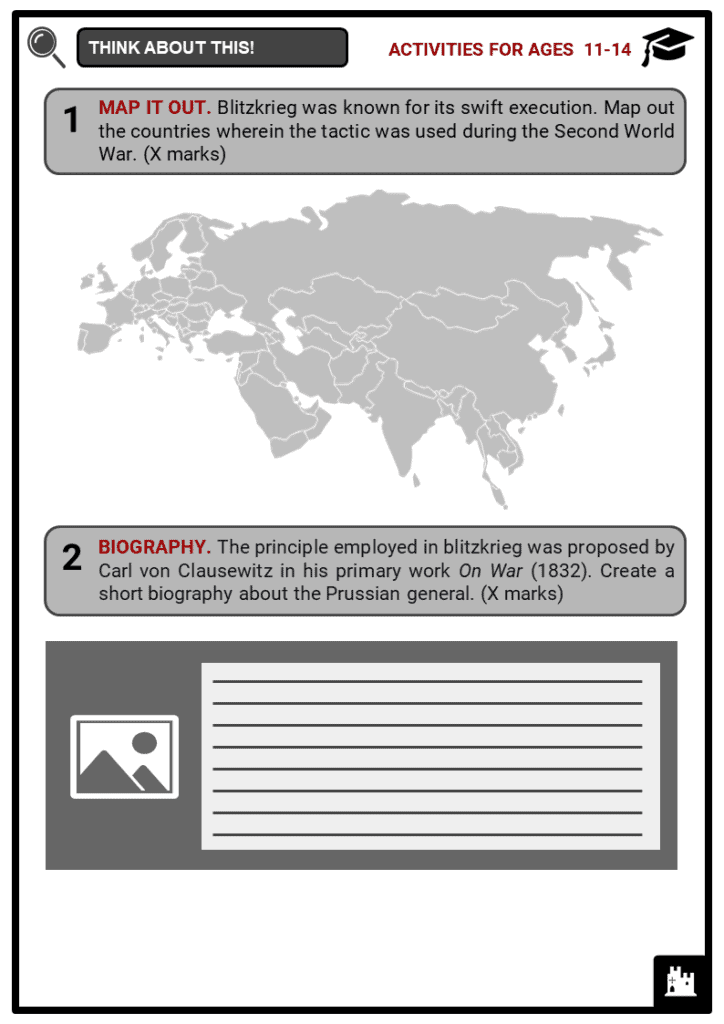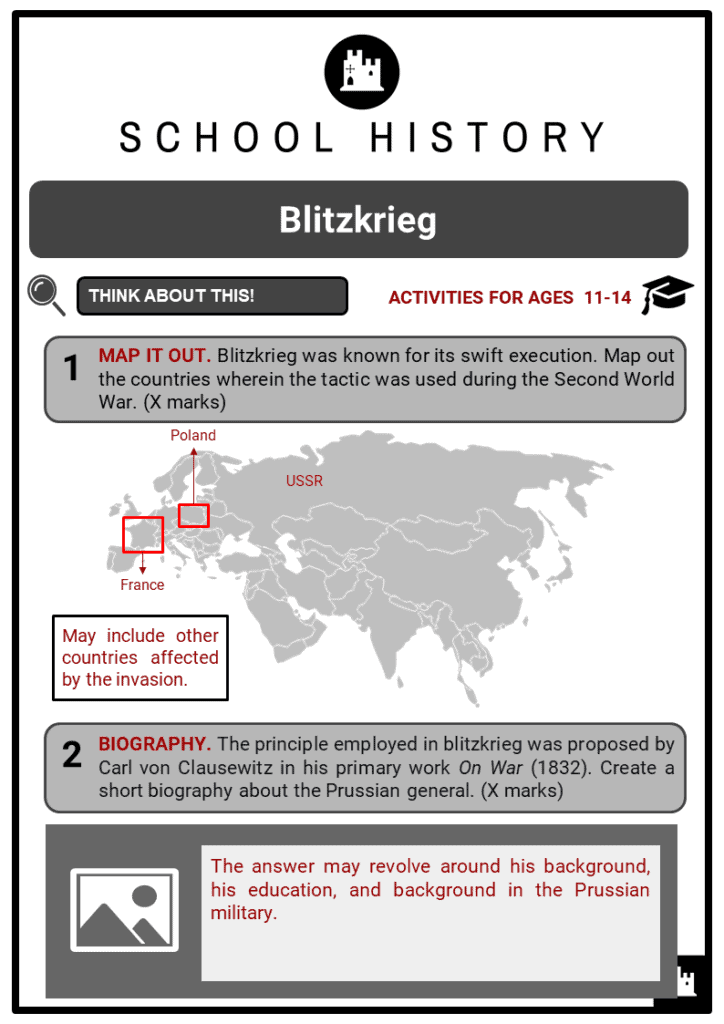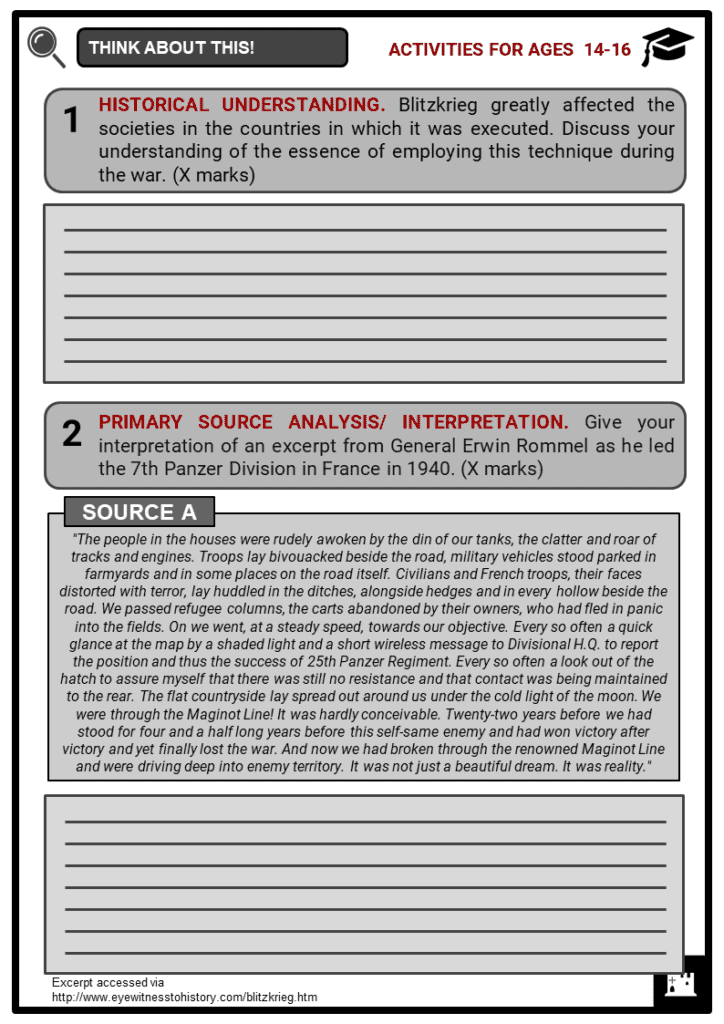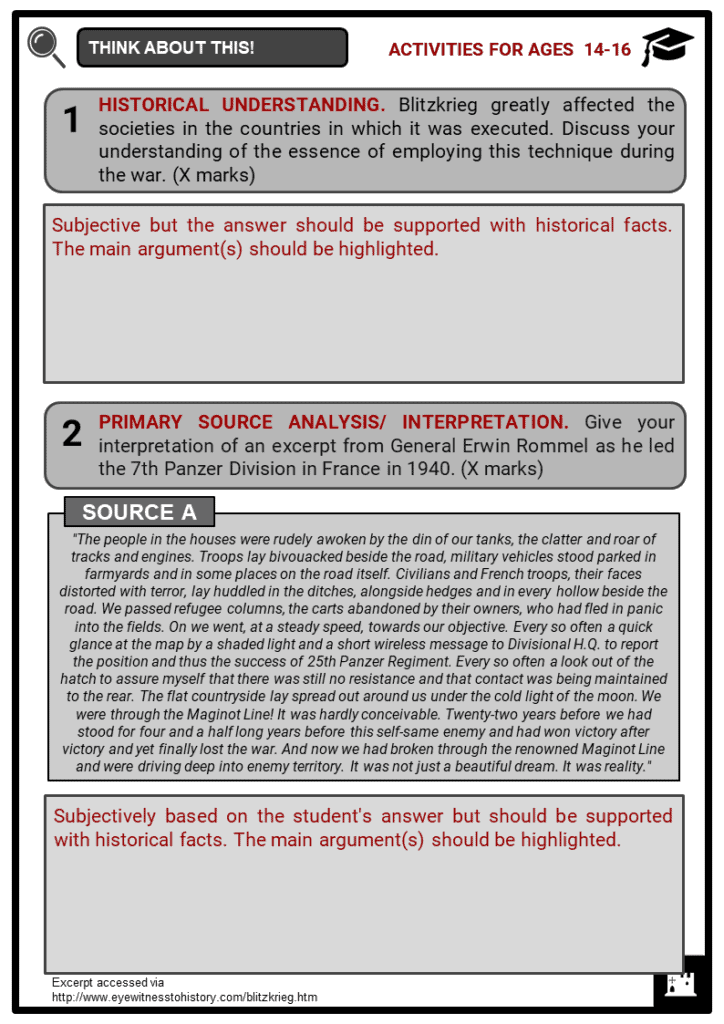Download Blitzkrieg Worksheets
Do you want to save dozens of hours in time? Get your evenings and weekends back? Be able to teach Blitzkrieg to your students?
Our worksheet bundle includes a fact file and printable worksheets and student activities. Perfect for both the classroom and homeschooling!
Table of Contents
Add a header to begin generating the table of contents
Summary
- The origin of Blitzkrieg as a military technique
- The strategies involved in the Blitzkrieg
- The countries where Blitzkrieg was used
Key Facts And Information
Let’s find out more about Blitzkrieg!
- Blitzkrieg is a military technique that consists of a violent surprise attack on the enemy. It seeks to confuse the opponent on a physical and psychological level in order to eliminate any of their chances of fighting back.
- Technological improvements and inventions – such as the use of radio communications, aeroplanes and motor vehicles – allowed the Blitzkrieg to be successful. The main objective was that of triggering disorganisation. Therefore, time, coordination and concentration are essential for a successful blitzkrieg.
Origins of Blitzkrieg
- One of the most common mistakes is the thought that blitzkrieg was an invention of Hitler and his followers. On the contrary, it was a tactic that existed prior to WWII and in order to understand its origins, one must look back to the Prussian Carl Von Clausewitz (1780-1831).
- Clausewitz was a “military philosopher” who wrote about war theories (Vardi 2008: 17; citing Azar Gat 1989: 162-200) and who had developed such a strategy by observing the Napoleonic Wars. In his perspective, the main objective throughout any war should be that of destroying the opponent on all levels, and as Clausewitz writes in his book On War, ‘’the [combat should be] a bloody and destructive test of physical and moral strength…the destruction of the enemy’s physical force [..] is the real purpose of the engagement” (Vardi 2008: 18; citing Clausewitz, Book II, 1: 127).
- During the Nazi era, General Heinz Wilhelm Guderian implemented Clausewitz theories into his attacks.
- Interestingly, the term ‘blitzkrieg’ originally was not an official military term, and rather, it was coined by the Time magazine after France had lost the war to Germany (Doughty 1998). Its etymology indicates its brutal and rapid nature: in German ‘blitz’ signifies ‘lightning’, whereas ‘krieg’ means ‘war’.
Strategies Involved
- Military strategists such as Schlieffen, Moltke, and Guderian developed a strong model of action for the German troops.
- Here is what their techniques consisted of:
- Avoiding the scattering of military forces and instead, focusing on the ‘concentration of forces’ within specific areas, i.e the Schwerpunkt (the ‘centre of gravity’) (Limbach, nd).
- Destroying and annihilating the opponent’s military forces. More precisely, it consists of ‘wearing out the enemy’ by ‘gradual exhaustion of the physical powers’ and ‘damaging them in a general way’.
- The strategy consisted of avoiding the most heavily defended areas and invading a country through its weakest entry points, disseminating panic, alarm, fear, agitation, disrupting their internal communications, and encircling the cities viewed as the ‘centre of gravity’ in order to ensure their collapse.
- The type of battle fought in WWI was not only set in trenches but was also static since all parties involved avoided advancing. On the contrary, throughout WWII, time was of the essence, and the secret to success consisted of moving and attacking in a rapid manner.
- It is without a doubt that the Germans were successful in their surprise attacks because of their efficient employment of technology. In fact, the German General Heinz Guderian introduced the use of ‘tanks, motor vehicles, aircraft and radios’ (Foley 2011).
- So – precisely – how was a blitzkrieg carried out?
- The attack was staged in two phases:
- Panzer tanks and airpower had the task of breaking into the enemy’s territory. Armoured vehicles preceded the tanks in order to look out for enemies and assess their strength.
- Once Germany invaded the country, the next step consisted of causing disruption and chaos. One of their ways to do so was by sending troops in urban areas in order to spread upheaval and wipe out any possible resistance.
- However, one must not undermine the strenuous and demanding conditions that soldiers had to endure throughout the attacks. In fact, they were obliged to ‘remain awake for long periods, march for miles, and fight in terrifying conditions fearlessly’ (Perry 2016).
- Some sources claim that soldiers of the Reich were taking methamphetamines such as Pervitin and crystal meth in order to endure the horrors of the war. In fact, according to Perry (2016), during 1940, 35 million tablets were handed out to the troops over the course of four months. Some of the side effects of such drugs were ‘irrational behaviour, hallucinations, enraged outbursts’ (Perry 2016).
Blitzkrieg in Action
- The blitzkrieg strategies were employed by Germany when invading and defeating Poland (1939), France (1940), Russia (1941), and Belgium (1944).
- On the 31st of August 1939, the German troops were getting ready for the invasion of Poland. On September 1, the German troops invaded the Polish territory whilst wearing their enemy’s uniform, and whilst attacking the radio station on the border with Germany. Three days later, France and Britain declared war on Germany, however, they had no idea how to react and sustain a war against their opponent. Poland was in serious danger, and Warsaw was surrounded by three territories controlled by Germany.
- The German victory was a result of their ability to surround and conquer the enemy from multiple sides. In fact, the Polish territory was invaded from the North-East front of Germany, East Prussia, Silesia and Slovakia: the invading north and south troops met in Warsaw and Brest-Litovsk.
- Polish aviation was outsmarted in only two days. Many Polish people were killed, and others were made prisoners. On September 27, Poland surrendered. The battle was a success for Hitler, and in only four weeks, he had conquered a country: Poland’s control was now being divided between Germany and the USSR.
- In May 1940, Germany entered France with extreme ease. Between 1929-38, France had built the Maginot Line, i.e. a strong fortification considered to be impenetrable on its border with Germany (leaving its border with Belgium uncovered). However, Germany attacked France in an unexpected manner: following General Manstein’s suggestion, the Reich breached the line through the Ardennes (a forest area bordering Germany, Belgium, and France) (Sheffield 2011).
- French infantry was superior in number, and also had more supply lines. However, this was not enough. In fact, their military strategies and appliances were outdated. For example, whereas Germans employed wireless technology and radio receivers to communicate all throughout the war, the French were still using flags in order to indicate that the enemy was approaching.
- Moreover, its air force was not as strong and as fast as the Germans’. Although France possessed 3,500 tanks against Germany’s 2,500 tanks, they were not able to resist the attack and they lost their land in only seven weeks.
- Once again, the blitzkrieg technique proved that a superior number of artillery, troops and tanks could not win against a solid military philosophy and strategy. However, it is necessary to state that in the period between the First and Second World War, France experienced a decrease in military investments, believing that a period of lasting peace had finally been established. The outcome of this belief consisted of drastic military cuts and the reduction of military service training from three years to one year.
- The success of the blitzkrieg technique pushed Hitler to invade another great example of totalitarianism, Stalinist USSR (although these two powers had signed in 1939 the Molotov-Ribbentrop Pact, i.e. a pact of non-belligerence towards each other). Russia was certainly not expecting an attack not only because the Molotov pact ensured a ten-year peace and neutrality, but also because the Russian territory provided Germany with wheat, oil, copper and other raw materials that helped the Nazi country overcome their struggles throughout the war. Therefore, Stalin was confident that Hitler would not invade.
- Stalin was wrong and Hitler’s aversion to Communism and the Bolsheviks (which was bluntly stated in the Mein Kampf), was another problem the Nazis had to overcome. Their intention was that of wiping out the Slavic populations in order to replace them with German settlers.
- The German blitzkrieg – which caught the Soviet Union by surprise – wiped out over 150,000 of their opponent’s soldiers in less than a week, and by October 1941, ‘three million Soviet soldiers were prisoners of war’.
- It is in the battle of Stalingrad in 1942 that the efficiency of blitzkrieg is revealed once again: as Rees (2011) states, ‘more than 1,000 tons of bombs were dropped on the city’ that was not evacuated, and soldiers would live on average for just 24 hours.
Success of Blitzkrieg
- What made the Blitzkrieg a successful strategy was its unpredictable, surprising, shocking nature. Not only did tanks and troops advance during the nighttime, but also, they were self-sufficient since they possessed a supply of food, water, bullets, and explosives that were sufficient for nine days.
- One of the elements that favoured this strategy consisted in not directly focusing on the physical destruction of the enemy.
- Rather, the focus would be on disorganisation and cutting off connections and communications within the occupied territory: the objective was that of paralysing the defendant. In fact, it is no surprise that particular attention was placed upon the attacking of official institutions and corporations.
- Moreover, in the first part of the Second World War, the Germans had a profitable outcome in the occupation of Europe because they were able to simultaneously employ air and land movement.

